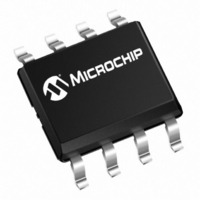34LC02-I/MS Microchip Technology, 34LC02-I/MS Datasheet - Page 6

34LC02-I/MS
Manufacturer Part Number
34LC02-I/MS
Description
IC EEPROM 2KBIT 1MHZ 8MSOP
Manufacturer
Microchip Technology
Specifications of 34LC02-I/MS
Memory Size
2K (256 x 8)
Package / Case
8-MSOP, Micro8™, 8-uMAX, 8-uSOP,
Format - Memory
EEPROMs - Serial
Memory Type
EEPROM
Speed
1MHz
Interface
I²C, 2-Wire Serial
Voltage - Supply
2.2 V ~ 5.5 V
Operating Temperature
-40°C ~ 85°C
Organization
256 K x 8
Interface Type
I2C
Maximum Clock Frequency
1 MHz
Access Time
400 ns
Supply Voltage (max)
5.5 V
Supply Voltage (min)
2.2 V
Maximum Operating Current
3 mA
Maximum Operating Temperature
+ 85 C
Mounting Style
SMD/SMT
Minimum Operating Temperature
- 40 C
Operating Supply Voltage
2.5 V, 3.3 V, 5 V
Lead Free Status / RoHS Status
Lead free / RoHS Compliant
Lead Free Status / RoHS Status
Lead free / RoHS Compliant, Lead free / RoHS Compliant
34AA02/34LC02
2.0
The 34XX02 has two Software Write-Protect features
that allow you to protect half of the array from being
written (Addresses 00h-7Fh). One command, Software
Write-Protect (SWP) will prevent writes to half of the
array and is resettable by using the Clear Software
Write-Protect (CSWP) command. The other command
is Permanent Software Write-Protect (PSWP), which is
not resettable and will permanently lock half the array
from being written to. The device still has an external
pin (WP) that allows you to protect the entire array if so
desired.
The 34XX02 supports a bidirectional 2-wire bus and
data transmission protocol. A device that sends data
onto the bus is defined as a transmitter, and a device
receiving data, as a receiver. The bus has to be
controlled by a master device, which generates the
Serial Clock (SCL), controls the bus access and gener-
ates the Start and Stop conditions, while the 34XX02
works as slave. Both master and slave can operate as
transmitter or receiver, but the master device
determines which mode is activated.
3.0
The following bus protocol has been defined:
• Data transfer may be initiated only when the bus
• During data transfer, the data line must remain
Accordingly, the following bus conditions have been
defined (Figure 3-1).
3.1
Both data and clock lines remain high.
3.2
A high-to-low transition of the SDA line while the clock
(SCL) is high determines a Start condition. All
commands must be preceded by a Start condition.
3.3
A low-to-high transition of the SDA line while the clock
(SCL) is high determines a Stop condition. All
operations must be ended with a Stop condition.
3.4
The state of the data line represents valid data when,
after a Start condition, the data line is stable for the
duration of the high period of the clock signal.
The data on the line must be changed during the low
period of the clock signal. There is one clock pulse per
bit of data.
DS22029E-page 6
is not busy.
stable whenever the clock line is high. Changes in
the data line while the clock line is high will be
interpreted as a Start or Stop condition.
FUNCTIONAL DESCRIPTION
BUS CHARACTERISTICS
Bus Not Busy (A)
Start Data Transfer (B)
Stop Data Transfer (C)
Data Valid (D)
Each data transfer is initiated with a Start condition and
terminated with a Stop condition. The number of data
bytes transferred between the Start and Stop
conditions is determined by the master device and is,
theoretically, unlimited; although only the last sixteen
will be stored when doing a write operation. When an
overwrite does occur, it will replace data in a first-in,
first-out (FIFO) fashion.
3.5
Each receiving device, when addressed, is obliged to
generate an Acknowledge after the reception of each
byte. Exceptions to this rule relating to software write
protection are described in Section 7.0 “Write Protec-
tion”. The master device must generate an extra clock
pulse, which is associated with this Acknowledge bit.
The device that acknowledges has to pull down the
SDA line during the Acknowledge clock pulse in such a
way that the SDA line is stable low during the high
period of the acknowledge related clock pulse. Of
course, setup and hold times must be taken into
account. During reads, a master must signal an end-of-
data to the slave by not generating an Acknowledge bit
on the last byte that has been clocked out of the slave.
In this case, the slave (34XX02) will leave the data line
high to enable the master to generate the Stop
condition.
Note:
Acknowledge
The 34XX02 does not generate any
Acknowledge
programming cycle is in progress.
2010 Microchip Technology Inc.
bits
if
an
internal














